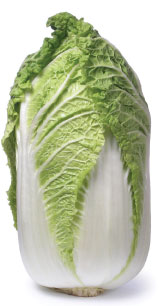
Features
Production
Research
Beating back clubroot infections in crucifera crops
in crucifera crops
April 24, 2008 By Dan Woolley
Asian crucifera crops are becoming
more important in Canada’s horticulture industry with about 1,800
hectares planted to the crops in Ontario, including 680 hectares of
Napa (Chinese cabbage).
However, warns Kevin Vander Kooi, a University of Guelph research
technician, these crops are vulnerable to the development of clubroot,
a disease caused by the soilborne fungus Plasmodiophora brassicae.
 Asian crucifera crops are becoming more important in Canada’s horticulture industry with about 1,800 hectares planted to the crops in Ontario, including 680 hectares of Napa (Chinese cabbage).
Asian crucifera crops are becoming more important in Canada’s horticulture industry with about 1,800 hectares planted to the crops in Ontario, including 680 hectares of Napa (Chinese cabbage).
However, warns Kevin Vander Kooi, a University of Guelph research technician, these crops are vulnerable to the development of clubroot, a disease caused by the soilborne fungus Plasmodiophora brassicae.
Clubroot is considered one of the most important diseases affecting the mustard or Cruciferae plant family. Infection can be extensive before symptoms begin to show in the field. First signs of the disease include abnormal plants wilting and yellowing of the leaves on warm days. In early growth stages, the young plants become stunted and die, while plants in the later stages of growth fail to grow or form marketable heads. When the roots of the infected plants are pulled from the ground, they appear swollen and distorted.
P. brassicae is capable of living in the soil for seven to 10 years in the form of resting spores. These spores can spread from field to field through infested soil, contaminated water, infected transplants, and contaminated farm machinery. When soil conditions are right – moist, acidic soil with a temperature range of 12 to 27 C – the spores germinate to produce zoospores, which can “swim” through the soil and infect susceptible plant roots.
Vander Kooi has done research examining the role soil and air temperatures play in the development of clubroot. In a three-year trial, he established a series of sequential plantings, with varying planting dates from June to September. Temperature sensors were installed at one metre above the soil and at soil depths of five, 10 and 15 metres.
From his results, Vander Kooi found that as air temperatures increased, so too did the incidence of disease as a direct correlation. Moreover, there was a high correlation in soil temperatures and increased disease incidence, with the greatest correlation between mean average temperature and disease occurring at between five and 10 days before the harvest. He also found that the greater the soil depth, the less correlation there was between temperature and disease incidence.
Clubroot occurs around the world and can really only be effectively managed by keeping any contaminated crucifer transplants from entering a farm operation. Vander Kooi stresses that susceptible crops should never be planted in infected land. The most susceptible cultivars include: cabbage, Chinese cabbage, Brussels sprouts, and some varieties of turnip. Cultivars with medium susceptibility include: kohlrabi, kale, cauliflower, collards, broccoli, rutabaga, seakale, plus some varieties of turnip and radish. Mildly susceptible cultivars include: canola, black mustard, and some varieties of turnip and radish. Very resistant cultivars include: winter cress, horseradish, garden cress and some varieties of radish.
P. brassicae is also capable of infecting the roots of red clover, poppy, plus orchard, bent, velvet and rye grass.
Vander Kooi recommends not planting any Asian crucifera vegetables in wet, poorly drained fields or in muck soils.
It is also recommended that growers:
• always use healthy transplants that are officially certified as such and reject the entire lot of transplants if traces of clubroot infection are found
• carefully choose sites for crucifer seedbeds that do not have a history of clubroot
• always clean farm equipment thoroughly after working in a field suspected of being infected
• use a seven-year rotation for susceptible crucifer varieties (for this to be effective, make sure susceptible weed species are also removed)
• use resistant varieties (breeders in the U.S. are currently working on various clubroot-resistant cabbage lines)
In fields that have become infected with clubroot, liming the soil can be used as a method of controlling the disease. According to researchers with Agriculture and Agri-Food Canada, while this will not eradicate clubroot, it will create conditions unfavourable for disease development by raising the soil pH (preferably above 7.2) and increasing the concentration of calcium in the soil. Applications of lime may have to be made every year, preferably in the fall.
Other methods of control in already infected fields include:
• the use of fungicides, such as quintozene (please check labels and make sure it is registered for use in your area)
• soil fumigation (several types are available, check with provincial crop specialists to ensure they are registered for use in your area)
• the use of bait crops for late plantings (the susceptible crop is plowed under four to five weeks after planting and the first generation of zoospores has no time to complete its cycle).
With files from Agriculture and Agri-Food Canada and Cornell University.
Print this page